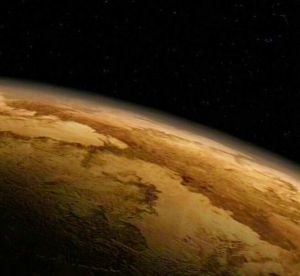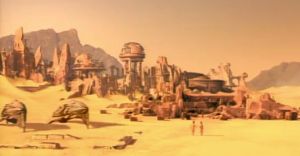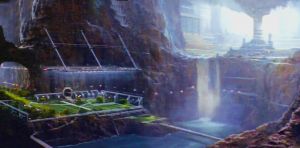Ocampa system
Ocampa is an inhabited planetary system in the Delta Quadrant. It is a single-star system, with the primary star, "Ocampa" being a G-type star.
This system is located approximately fifty thousand light years from the galactic core, and seventy-five thousand light years from the Badlands in the Alpha Quadrant.
One planet in this system was the homeworld of the Ocampa people.
- Ocampa I
- Ocampa II
- Ocampa III
- Ocampa IV
- Ocampa V: Sometimes just called "Ocampa," this is the homeworld of the Ocampan people.
In the people's 14th century, Ocampa was a typical class M planet, until it was visited by a group of extragalactic travelers known as the Nacene.
In what the Ocampa refer to as "The Warming," the Nacene accidentally removed all nucleogenic particles from the atmosphere and turned the planet into a desert.
By the 24th century, the Kazon-Ogla had established a mining colony on the surface of Ocampa V. The Kazon also made numerous attempts to access the underground Ocampa city, but a subterranean forcefield kept them out. However, several curious Ocampa managed to break through the barrier, and were subsequently captured by the Kazon.
Some Ocampa began to research old records, in order to improve their knowledge of science and technology. This group remained beneath the surface of Ocampa V, in the underground city they had built, developing different forms of power and life support system generation. Another group chose to move back onto the surface of the planet, trying to find ways to restore their damaged biosphere. Though these Ocampa had to fight against the Kazon who continued to live on the surface, they viewed this sacrifice well worth the effort.
By 2371, most of the water on the surface of Ocampa V had evaporated, leaving behind large expanses of salt flats. Only 30% of the surface continued to be covered in water, with most of it located at the polar regions or around the equator. In addition, the "Equatorial Ocean" divided the planet into two large continents, one in the northern hemisphere and one in the southern hemisphere.
Both continents experience regular dust storms. These storms, coupled with the hot, dry climate, proves top-ground life difficult for sentient and non-sentient life alike. Only those who are able to find water can survive.


